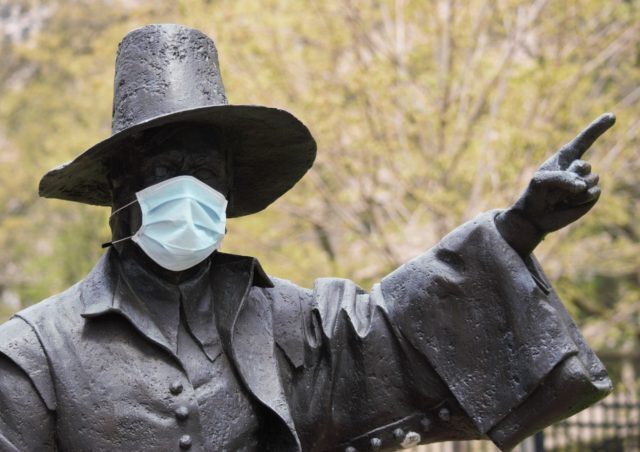Rev. Samuel Stone
The Rev. Samuel Stone, who I have seen described as “a Puritan’s Puritan” is depicted outside Center Church in exactly the kind of pose we would expect from someone rolling holier than thou.
In 1648, Mary Johnson — a house servant who resided in Hartford, and later, Wethersfield — confessed to witchcraft following pressure from Samuel Stone. The torture and torment began two years before her confession, and her execution was postponed until 1650 when she delivered her baby, who was reported to be raised by her jailer’s son.
It is unclear if she had been accused by anyone of witchcraft, but she had two prior accusations of thievery. According to Cotton Mather, she had confessed to committing “uncleanness both with men and with devils.” You could say she made an easy target.
Who knows what drove Stone to shakedown Mary Johnson. His behavior was supported by the people of his time. She may have been the first in the thirteen colonies to confess to witchcraft, but she was one of sixteen sentenced to death for this “crime” in Connecticut.
What kind of a society allows for that?
A fearful one.
As Connecticut Explored explains, it was fear that “created an environment that fostered witchcraft accusations. Wethersfield residents, for their part, had plenty to fear. They could lose their sheep and other farm animals to wolf and bear attacks. The Connecticut River could flood at any time, wiping out crops. Epidemics visited the region in 1647 and 1648, killing dozens of townspeople in an already small and unstable population.”
Epidemics? Influenza, or what was referred to as the “jolly rant.” It was widespread in New England and apparently did not let up in summer, with this outbreak actually being noted as starting in May 1647. This flu is what took Rev. Thomas Hooker in July 1647. Hooker and Stone knew each other a long time, coming from England on the same ship, working together in Cambridge, and traveling together to establish Hartford.
Around the same time, Alse Young of Windsor was accused of and executed for witchcraft in May 1647, just as the mysterious illness began afflicting many in what would be described as a “moderately severe” outbreak by today’s standards. Historians have speculated more firmly that Young served as a scapegoat during the flu outbreak.

Horace Wells
Two centuries after Mary Johnson’s pressured (can we just call it a forced confession already?) confession, Horace Wells’ substance abuse caught up with him.
The dentist made claims to discovering anesthesia (sulphuric ether), experimenting on himself for a period of years. He has been described as respected in Hartford, and known for caring about the comfort of his patients. He opened, closed, and reopened his dentistry business numerous times, finally moving to New York City ahead of his wife and child, where it seems he began self-medicating out of loneliness.
He was arrested in 1848 for what the Christian Secretary described as “throwing vitriol upon the dresses and persons of certain females who are in the nightly habit of promenading Broadway.” Wells initially denied this, saying that he was “under the influence of ether or chloroform” and gave a friend “a vial of sulphuric acid for the purpose of throwing it upon a female against whom he had some ill feelings.” Later, in a letter, he admitted that he took the vial that he had prepared for a friend, and while high on chloroform, wandered out his door and tossed it on the first two women he encountered. Other news coverage by the Hartford Daily Courant refers to seven “nymphs” who complained about the acid attack; other reports described the victims as prostitutes.
Various sources noted that this behavior is not what one would have expected from Wells, though his friends would admit that his mental health had been in decline — likely the result of long term use of anesthetics.
It was while jailed for this incident that Wells, under the influence of ether, committed suicide.
It’s no secret that Hartford’s statue collection is wanting for improvement, both in terms of diversity and in who is deemed statue-worthy in general (with a few exceptions). The one thing that the COVID-19 masks-on-statues stunt does is finally give Stone and Wells the opportunity to model behaviors people should be emulating.

Tony C
Yeah. Why aren’t there more statues of historic women in Hartford?
Kerri Provost
Because women only get to be portrayed as symbols or we have to share the podium with children or men.
Any of these women could get statues, and as far as I know, none threw acid on prostitutes or forced an ‘improper’ woman to give a questionable confession to crimes punishable by death:
– Katharine Houghton Hepburn (suffrage pioneer)
-Beatrice Auerbach Fox (if Henry Keney could demand a monument be build in tribute to his family’s business, we can acknowledge BAF’s role in turning what began as her grandfather’s business into the largest department store in New England)
-Mary Townsend Seymour (an early civil rights advocate, co-founding Hartford’s NAACP chapter in 1917)
-Lydia Sigourney (educator, author, poet — one of her poems was adapted into a song by Natalie Merchant)
– Harriet Beecher Stowe (She deserves to be portrayed on her own)
-Ann Uccello (first female mayor of a U.S. state capital)
-Carrie Saxon Perry (first African American female to be mayor of a major New England city *and* addressed some social justice issues while serving in this role)
And that’s just off the top of my head. If I did any research, I could make that list five times longer probably in the span of a half hour.
There are women buried in that Ancient Burying Ground. Certainly any of them contributed at least as much as the ‘founding fathers.’ Building new statues might not be a prudent use of money, but we could acknowledge that what we have and what we should have are very different things.
RICHARD
Now that would make a good virtual tour. Go around with photo’s of some of our great women stand where they should be placed photo in hand. Give a blurb about each one. Three statues I could do without are, Samuel Stone, Christopher Columbus, and Samuel Colt. That Pulaski on his horse has an interesting story that Steve Thornton wrote about.
Kerri Provost
Thanks for that idea. I may run with it.
Richard
Yes take it and run move it out to new heights. All keys are needed to smash the patriarchy even among statue hood. I love the virtual walking tours as I don’t live in Hartford anymore, and even if I did I am too old and lazy with aches and pains to go walking very far. Learn a lot too from your walks. I am always amazed at the places you go.